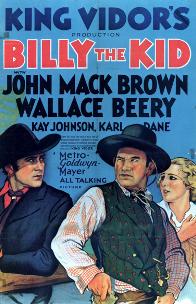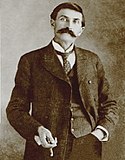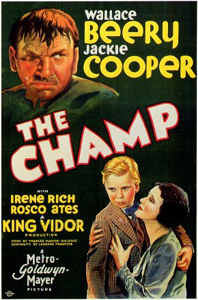
The Champ is a 1931 American pre-Code film starring Wallace Beery and Jackie Cooper and directed by King Vidor from a screenplay by Frances Marion, Leonard Praskins and Wanda Tuchock. The picture tells the story of a washed-up alcoholic boxer (Beery) attempting to put his life back together for the sake of his young son (Cooper).
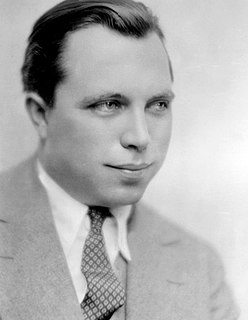
King Wallis Vidor was an American film director, film producer, and screenwriter whose 67-year film-making career successfully spanned the silent and sound eras. His works are distinguished by a vivid, humane, and sympathetic depiction of contemporary social issues. Considered an auteur director, Vidor approached multiple genres and allowed the subject matter to determine the style, often pressing the limits of film-making conventions.

Wallace Fitzgerald Beery was an American film and stage actor. He is best known for his portrayal of Bill in Min and Bill (1930) opposite Marie Dressler, as General Director Preysing in Grand Hotel (1932), as Long John Silver in Treasure Island (1934), as Pancho Villa in Viva Villa! (1934), and his titular role in The Champ (1931), for which he won the Academy Award for Best Actor. Beery appeared in some 250 films during a 36-year career. His contract with Metro-Goldwyn-Mayer stipulated in 1932 that he would be paid $1 more than any other contract player at the studio. This made Beery the highest-paid film actor in the world during the early 1930s. He was the brother of actor Noah Beery and uncle of actor Noah Beery Jr.

The Lincoln County War was an Old West conflict between rival factions which began in 1878 in New Mexico Territory, the predecessor of the state of New Mexico, and continued until 1881. The feud became famous because of the participation of William H. Bonney. Other notable participants included Sheriff William J. Brady, cattle rancher John Chisum, lawyer and businessman Alexander McSween, James Dolan and Lawrence Murphy.

John Brown was an American college football player and film actor billed as John Mack Brown at the height of his screen career. He acted and starred mainly in Western films.

Noah Nicholas Beery was an American actor who appeared in films from 1913 until his death in 1946. He was the older brother of Academy Award-winning actor Wallace Beery as well as the father of prominent character actor Noah Beery Jr. He was billed as either Noah Beery or Noah Beery Sr. depending upon the film.
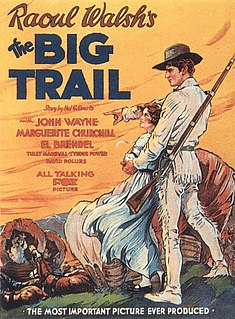
The Big Trail is a 1930 American pre-Code Western early widescreen film shot on location across the American West starring 23-year-old John Wayne in his first leading role and directed by Raoul Walsh.
70mm Grandeur film, also called Fox Grandeur or Grandeur 70, is a 70mm widescreen film format developed by William Fox through his Fox Film and Fox-Case corporations and used commercially on a small but successful scale in 1929–30.
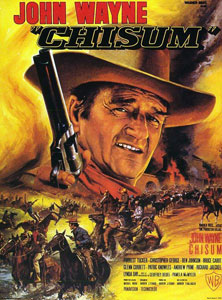
Chisum is a 1970 American Western film directed by Andrew McLaglen, starring John Wayne in the titular role, and adapted for the screen by Andrew J. Fenady from his short story "Chisum and the Lincoln County War." The supporting cast features Forrest Tucker, Christopher George, Ben Johnson, Glenn Corbett, Andrew Prine, Bruce Cabot, Patric Knowles, Richard Jaeckel, Lynda Day George, Pedro Armendariz Jr., John Agar, John Mitchum, Ray Teal, Christopher Mitchum and Hank Worden with Geoffrey Deuel and Pamela McMyler receiving "introducing" credits. The picture was filmed in Panavision and Technicolor.

John Simpson Chisum was a wealthy cattle baron in the American West in the mid-to-late 19th century. He was born in Hardeman County, Tennessee, and moved with his family to the Republic of Texas in 1837, later finding work as a building contractor. He also served as county clerk in Lamar County. He was of Scottish, English, and Welsh descent.
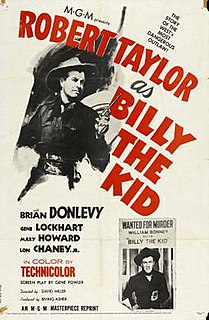
Billy the Kid is a 1941 American Western film, a color remake of the 1930 film of the same name. The film features Robert Taylor as Billy and Brian Donlevy as a fictionalized version of Pat Garrett renamed "Jim Sherwood" in the film. Directed by David Miller and based on the book by Walter Noble Burns, the cast also included Gene Lockhart and Lon Chaney Jr. The film was not as well received as the 1930 original, Billy the Kid, which had starred Johnny Mack Brown and Wallace Beery and been shot in an experimental widescreen process.

Our Daily Bread is a 1934 American drama film directed by King Vidor and starring Karen Morley, Tom Keene, and John Qualen. The film is a sequel to Vidor's silent classic The Crowd (1928), using the same characters although with different actors. Vidor tried to interest Irving Thalberg of MGM in the project; but Thalberg, who had greenlighted the earlier film, rejected the idea. Vidor then produced the film himself and released it through United Artists. The film is also known as Hell's Crossroads, an American reissue title.

Old Ironsides (1926) is a silent film starring Charles Farrell, Esther Ralston, Wallace Beery, and George Bancroft.

The Left Handed Gun is a 1958 American Western film and the film directorial debut of Arthur Penn, starring Paul Newman as Billy the Kid and John Dehner as Pat Garrett.
The Battle of Lincoln, New Mexico, was a five-day-long firefight between the Murphy-Dolan Faction and the Regulators that took place between July 15–19, 1878, in Lincoln, New Mexico. It was the largest armed battle of the Lincoln County War in the New Mexico Territory. The firefight was interrupted and suppressed by United States Cavalry led by Lt. Col. Nathan Dudley from Fort Stanton.

Gore Vidal's Billy the Kid, also known as Billy the Kid, is a 1989 American western television film about famed gunman Billy the Kid. It aired on TNT cable channel on May 10, 1989.

The Kid from Texas is a 1950 American Western film that was Audie Murphy's first Technicolor Western and the first feature film on Murphy's Universal-International Pictures contract. It was directed by Kurt Neumann and featured Gale Storm and Albert Dekker.

The legend of Billy the Kid has acquired iconic status in American folklore, yet the outlaw himself, also known as William Bonney, had minimal impact on historical events in New Mexico Territory of the late 1800s. More has been written about Billy the Kid than any other gunslinger in the history of the American West, while hundreds of books, motion pictures, radio and television programs and even a ballet have been inspired by his legend.

I Shot Billy the Kid is a 1950 American Western film directed by William Berke for Lippert Pictures.
